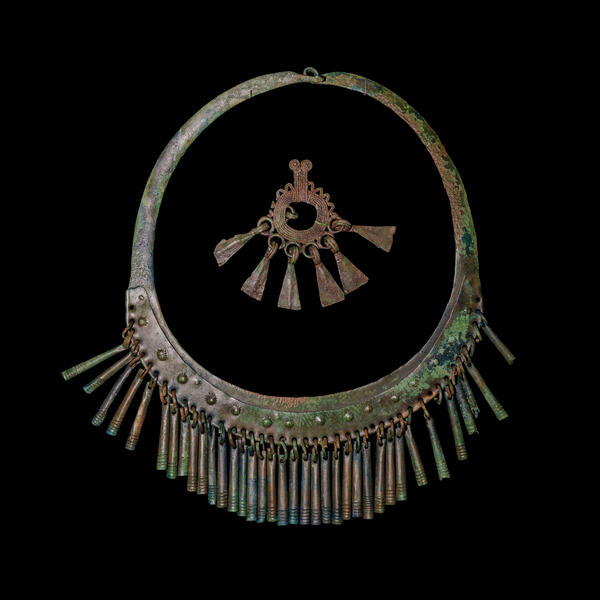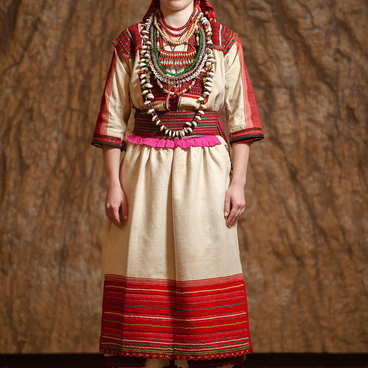The sickle-shaped torc with rattle pendants was discovered during excavations of the Zhuravkino burial ground II in the Zubovo-Polyansky district of the Republic of Mordovia. This archaeological monument of the ancient Mordovians is located near the village of Zhuravkino, in the southwestern part of the republic on the high left bank of the Vad River. The excavations were carried out by the archaeologists Ivan Peterburgsky and Viktor Vikhlyaev who examined a total of 76 burials. The grave of a rider contained a snaffle bit, a bridle with silver plaques, stirrups and remnants of a saddle made of wood and birch bark. Among the rare finds was a double-bladed sword of Western type. In some graves there were burial goods: tools, weapons, clay molded vessels, jewelry, including women’s temple pendants with a spiral and a bi-pyramidal weight, metal headbands, chest plate plaques, rod and sickle-shaped (ribbon) neck torcs, and syulgams.
The artifact is a neck ornament with embossing on the superimposed front plate and a hook clasp. There are two rows of convex dots at the top of the piece, as well as a row of large convex dots in the middle. Rattle conical pendants — thin plates with embossing in the form of transverse convex bands at the bottom — are attached to the lower part of the torc by rings. Such a torc is a typical Mordovian neck ornament; its analogs are found in all the Mordovian, mainly Moksha, burials of the 8th–11th centuries. Various ornaments and other items found in ancient burials indicate the local people’s belief in the afterlife: they were placed with the deceased in the graves to serve them “in the other world”.
Archaeological research made it possible to map the territory of the settlement of the Mordovian tribes since ancient times and to study their close relations with neighboring tribes and peoples. The settlement area of the Mordovian tribes, covering significant areas between the Oka, Sura and Volga rivers, was an arena of important events since time immemorial. These areas were in close contact with the nomadic south, the tribes of the Kama and the Urals. Archaeological materials reveal these relations from the first centuries of the Common Era.
The artifact is a neck ornament with embossing on the superimposed front plate and a hook clasp. There are two rows of convex dots at the top of the piece, as well as a row of large convex dots in the middle. Rattle conical pendants — thin plates with embossing in the form of transverse convex bands at the bottom — are attached to the lower part of the torc by rings. Such a torc is a typical Mordovian neck ornament; its analogs are found in all the Mordovian, mainly Moksha, burials of the 8th–11th centuries. Various ornaments and other items found in ancient burials indicate the local people’s belief in the afterlife: they were placed with the deceased in the graves to serve them “in the other world”.
Archaeological research made it possible to map the territory of the settlement of the Mordovian tribes since ancient times and to study their close relations with neighboring tribes and peoples. The settlement area of the Mordovian tribes, covering significant areas between the Oka, Sura and Volga rivers, was an arena of important events since time immemorial. These areas were in close contact with the nomadic south, the tribes of the Kama and the Urals. Archaeological materials reveal these relations from the first centuries of the Common Era.



